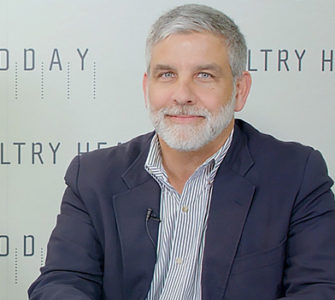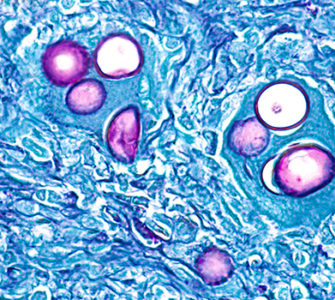Tyson vet shares experiences with antibiotic-free broilers
Producing Salmonella-free chicks without antibiotics is a delicate procedure — sort of like baking a cake, says Scott Gustin, DVM, director of veterinary services for Tyson. You need to start with high-quality ingredients and pay close attention to details.
“All your ingredients go into the hatchery — that’s your mixing bowl,” he says. “If you get bad ingredients in, that’s what you’re dealing out to all these broiler farms.”
For that reason, he says, they begin monitoring for Salmonella at the hatchery. “We want to prevent vertical transmission from occurring; we want to know what serotypes are out there and then go and chase those we do find if one is problematic in an operation,” Gustin told Poultry Health Today.
Once birds are in the grower barns, their attention shifts to intestinal health. Necrotic enteritis (NE) tops the list for bird mortality in ABF flocks, Gustin says. Coccidiosis plays a big role in the severity of NE and requires constant management.
“Each farm and program have specific factors that affect coccidiosis levels including stocking density — plus there’s a seasonal component as well,” Gustin explains. “Sometimes just cleaning out the house and starting fresh creates new problems.”
In ABF production, management must look closely at the whole program including includes diets, diet transitions, feed ingredients and alternative products.
For example, the starter rations should focus on lower protein levels of highly digestible ingredients. According to Gustin, avoiding transitions in feed rations during peak coccidial-oocyst production at days 17 and 28 is important in ABF programs.
“We need to feed highly digestible ingredients and fewer poorly digestible by-products,” he said, “but that doesn’t necessarily mean we have to use an all-vegetable program. I think we can still use quality animal proteins.”
Managing gut health — through diet — is an important factor in keeping birds healthy in ABF production. “We’ve been forced to look at products that help maintain the gut integrity of the bird,” he explained. Alternative products focused on gut health include probiotics, prebiotics, phytogenics, organic acids and essential oils.
While Gustin doesn’t see any new diseases cropping up in ABF production, he admits that ionophores — a class of antibiotics used to prevent coccidiosis — were covering up some health issues growers thought were under control.
While condemnation levels are similar between conventional and ABF production, things like paw quality linked to vegetarian diets and litter moisture levels need to be watched more closely, he said.
“On the live side of poultry production, we’re always looking for management practices to decrease contamination,” he said. “We depend on our growers and other health officials to identify and implement these new programs.”
At the root of ABF production lies the ethical dilemma of bird welfare. “As veterinarians, we must establish thresholds for palliative care including antibiotic use based on what is best for the birds and hold ourselves to those thresholds,” Gustin said.
Posted on June 2, 2016
















